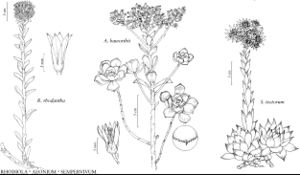Difference between revisions of "Rhodiola"
Sp. Pl. 2: 1035. 1753.
Gen. Pl. ed. 5, 457. 1754 ,.
FNA>Volume Importer |
imported>Volume Importer |
||
| (2 intermediate revisions by 2 users not shown) | |||
| Line 69: | Line 69: | ||
|publication year=1753; | |publication year=1753; | ||
|special status= | |special status= | ||
| − | |source xml=https:// | + | |source xml=https://bitbucket.org/aafc-mbb/fna-data-curation/src/2e0870ddd59836b60bcf96646a41e87ea5a5943a/coarse_grained_fna_xml/V8/V8_329.xml |
|genus=Rhodiola | |genus=Rhodiola | ||
}}<!-- | }}<!-- | ||
-->[[Category:Treatment]][[Category:Crassulaceae]] | -->[[Category:Treatment]][[Category:Crassulaceae]] | ||
Latest revision as of 22:42, 5 November 2020
Herbs, perennial (dying back in winter to rootstock), not viviparous, 0.3–6 dm, glabrous [pubescent]. Stems a rootstock with apex mostly above ground, erect, spreading, or decumbent, commonly branching to form clumps, fleshy, with brown scalelike [or green] leaves; flowering stems from axils of brown scale-leaves on stout rootstock partly above ground. Leaves persistent, cauline, alternate, sessile, subclasping basally; blade elliptic to ovate or oblanceolate to linear, obovate, or oblong, laminar (mostly to 1 mm thick), 0.5–5.5 cm, somewhat fleshy, base not spurred, margins entire or toothed; veins not conspicuous. Inflorescences cymose or spikelike to subcapitate. Flowers bisexual or unisexual, erect, 4–6-merous; sepals connate basally, all alike (unequal in R. rosea); petals erect or spreading, distinct, greenish, white, rose, dark red, or yellowish; calyx and corolla not circumscissile in fruit; nectaries quadrate to linear; stamens 2 times as many as sepals, epipetalous; filaments mostly adnate to corolla at base; pistils erect, nearly distinct; ovary base straight; styles 2+ times shorter than ovary. Fruits erect. Seeds oblanceoloid or pyriform, ribbed, finely cross-ribbed.
Distribution
North America, Eurasia, montane to arctic areas.
Discussion
Species ca. 40 (3 in the flora).
In Rhodiola, inflorescences are borne in axils of scale leaves on the rootstocks, which are partly above ground. They are thinner and leafier than those of Hylotelephium. This treatment largely follows R. T. Clausen (1975), except that he made Rhodiola a subgenus of Sedum.
Selected References
None.
Lower Taxa
Key
| 1 | Inflorescences spikelike or subcapitate, 1-3.5 cm diam.; flowers bisexual; petals greenish or white to rose, 6-13 mm, longer than stamens; beaks of follicles erect. | Rhodiola rhodantha |
| 1 | Inflorescences corymbose cymes, to 8 cm diam.; flowers mostly unisexual (and plants mostly dioecious); petals yellow to greenish yellow and sometimes red at tips, or dark red and sometimes yellow basally and red apically, 1-5 mm, shorter than stamens; beaks of follicles spreading | > 2 |
| 2 | Petals mostly dark red, sometimes yellowish at base or yellow with apical 1/3 red, in staminate flowers 1.3-1.7 mm wide; leaf blades commonly bright green, sometimes glaucous. | Rhodiola integrifolia |
| 2 | Petals pale yellow to greenish yellow, sometimes red at tips, in staminate flowers 0.7-1.1 mm wide; leaf blades pale green, usually glaucous. | Rhodiola rosea |
